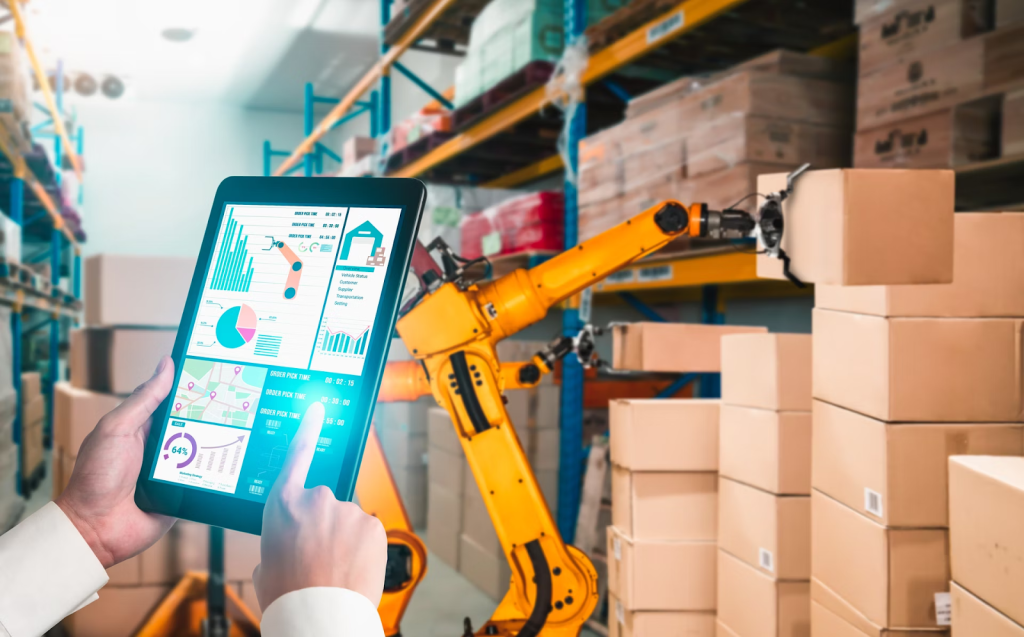Top 5 Emerging Trends in Logistics Technology for 2024

2024 is set to be a groundbreaking year for logistics technology. We’re talking about revolutionary advancements that will redefine the traditional boundaries of logistics. No, it’s no longer just about getting goods from point A to B — it’s about using the power of the latest technology, from robots strutting around warehouses to cloud-based solutions with clear visibility at maximum. Why? To make the process smarter, faster, and more efficient. The good news is that Trinetix Company has prepared for you the top 5 unmissable trends in logistics technology for 2024.
Trend 1. Say hello to supply chain agility
First, let’s talk about supply chain agility. No, we don’t mean the ability to stretch or bend — we mean quick response to market changes. Think of agility as being really good at improvising when a wrench gets thrown into your plans.
An agile supply chain doesn’t just look good on paper; it’s also a big money saver. This means less inventory, less money tied up in inventory, and less money lying around.
Now, you’re asking how to make your supply chain more agile. Well, here are some tips:
- Embrace technology like AI, machine learning, and automation. This is the digital age, my friend!
- Predict the future with data. Okay, maybe not the distant future, but data analytics can help you forecast market trends and customer demands. You’ll be able to plan your supply chain operations better and avoid any nasty surprises.
- Be best friends with your suppliers. Remember when you were a kid and shared everything with your best friend? That’s the kind of relationship you want with your suppliers. The better your relationship, the faster you can respond to changes in supply and demand.
- Train your team. Your team needs to understand the importance of agility in the supply chain — of course, to make decisions faster.
- Have a plan B…and C. Disruptions happen. And you need to have a plan in place, so try to turn challenges into opportunities.
- Keep your inventory lean. No one likes waste, right? Lean inventory practices mean just enough stock to meet demand without overstocking. More efficiency, less waste.
- Make your manufacturing flexible. If you can adjust your manufacturing processes based on demand, you’re golden. Think modular manufacturing systems or flexible production lines.
So, an agile supply chain keeps your business resilient, efficient, and competitive. And who doesn’t want that?
Trend 2. Robots are taking over (the warehouse)
You see, the idea of robots and automation taking over might seem like something out of a futuristic movie, but it’s actually happening right now. And trust us, it’s as cool as it sounds.
Forget about the manual, labor-intensive processes of the past as robots mean precision, efficiency, and speed. They can pick, pack, sort, and move goods through the warehouse more accurately than any human could.
And they’re not prone to human errors or fatigue. They can work 24 hours a day with no need for a lunch break or a vacation. And… they don’t call in sick on Mondays!
Robots also contribute to safer working conditions. They can lift heavy objects and perform potentially hazardous tasks — no more workplace injuries.
Sure, there’s an upfront investment, but you see, lower labor costs, fewer mistakes, less waste — it all adds up.

Trend 3. Reducing carbon footprints — because we care
You know, going green isn’t just a hip trend — it’s downright essential. And it’s not just us humans saying this; our planet is practically screaming it! The logistics industry, which has been a big part of the carbon emissions problem, is now becoming a part of the solution. And it’s exciting stuff!
Think about it like this: every truck, plane, or ship we use to move goods around is like a tiny factory billowing out greenhouse gases. But what if we could turn those factories off? That’s exactly what the industry is working on.
We’re seeing fleets of electric trucks and ships powered by biofuels. We’re seeing smarter, optimized routes that cut down on unnecessary miles. We’re seeing a massive push for renewable energy sources in warehouses and distribution centers. It’s all about reducing that carbon footprint, one step at a time.
But there’s another side to this green coin. It’s not just about doing good — it’s also about doing well. Customers today are savvy; they care about the planet and want to support businesses that do too. So, going green is also boosting the bottom line, right?
Trend 4. Light as a feather with asset-light logistics
Oh, the concept of asset-light logistics is a fascinating one. It’s like being able to drive a fancy car without worrying about the maintenance costs or even the monthly installments. Pretty sweet, isn’t it? Now, let’s unpack it a bit:
- Going asset-light means you have flexibility. You’re not tied down to a fleet of trucks or a network of warehouses. Need more capacity during peak season? No problem. Experiencing a lull? You can scale back easily.
- Then there’s the money factor. Buying and maintaining assets like trucks, ships, or warehouses can be incredibly expensive. However, these huge costs can be avoided with asset lightning.
- There’s also less risk involved. When you own assets, you’re exposed to things like market fluctuations, maintenance issues, or changes in regulations. But an asset-light model means these risks are shouldered by your partners.
- Finally, instead of worrying about managing a fleet of trucks or a warehouse, companies can focus on improving their products, services, or customer relationships.
So, you get the perks without the heavy lifting (pun intended!). And who doesn’t love having their cake and eating it too?
Trend 5. Rise of the cloud
And finally, there’s something even more exciting for you. We’re talking cloud-based tech solutions in logistics. No, no, not the fluffy marshmallow-like things floating in the sky. This is something way cooler and much more powerful.
Picture this: You’re sitting at your desk, sipping your coffee, and with just a few clicks, you can see everything that’s happening in your supply chain. Every truck, every warehouse, every package — it’s all there. Sounds like magic, but it’s not — it’s the power of the cloud!
Here are some of the mind-blowing things you can do with cloud-based tech in logistics:
- Remember the days when you had to call up the driver to check where the truck was? Those days are long gone! Now, you can track your shipments in real time.
- You know those confusing spreadsheets and endless numbers? The cloud gobbles them up and spits out insights that actually make sense. You can analyze performance, identify bottlenecks, and make data-driven decisions.
- Scalability. What about when your business grows? Well, the cloud grows with you. You can easily scale up (or down) your operations without any extra hassle.
- Cost savings. You don’t need to invest in expensive hardware or software. And you can say goodbye to costly maintenance and upgrades.
Well, logistics management has become a piece of cake. So, are you ready to take your logistics to the cloud and beyond?
Conclusion
Well, here it is. Now, you know everything about these incredible five trends in logistics technology for 2024. Can we expect the brightest future? Of course. Logistics will become sustainable and customer-centric at least. And it doesn’t matter who you are — a logistics pro or someone who loves to keep up with the latest trends — you’ll see this whole new logistics dimension.






